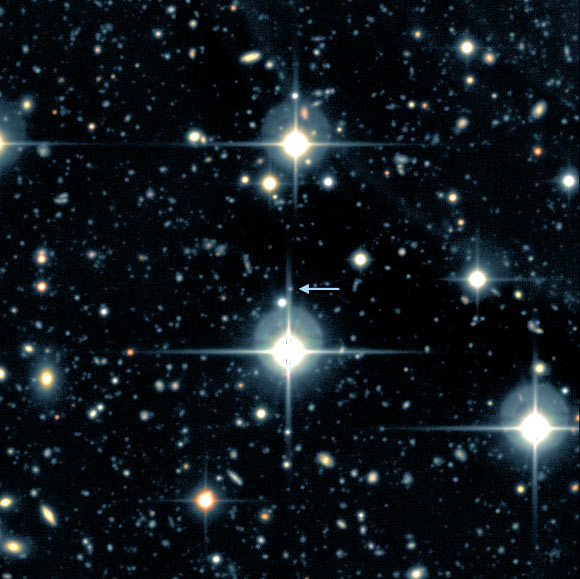According to an international group of astronomers, two unusual stellar explosions detected in 2006 and 2007 are a new subclass of superluminous supernova events.

This image shows the supernova SNLS-06D4eu and its host galaxy, arrow. The supernova and its host galaxy are so far away that both are a tiny point of light that cannot be clearly differentiated in this image. The large, bright objects with spikes are stars in our own galaxy. Every other point of light is a distant galaxy. Image credit: University of California, Santa Barbara.
The two supernovae, dubbed SNLS 06D4eu and SNLS 07D2bv, are the brightest and most distant stellar explosions ever recorded.
They are located about 10 billion light-years away from Earth, and are about a hundred times more luminous than a normal supernova.
SNLS 06D4eu and SNLS 07D2bv are puzzling because the mechanism that powers most of supernovae – the collapse of a giant star to a black hole or normal neutron star – cannot explain their extreme luminosity.
“At first, we had no idea what these things were, even whether they were supernovae or whether they were in our galaxy or a distant one,” said Dr D. Andrew Howel from Las Cumbres Observatory Global Telescope Network and the University of California, Santa Barbara, the lead author of the paper published in the Astrophysical Journal (arXiv.org).
“I showed the observations at a conference, and everyone was baffled. Nobody guessed they were distant supernovae because it would have made the energies mind-bogglingly large. We thought it was impossible.”
SNLS 06D4eu and SNLS 07D2bv belong to a special subclass of superluminous supernovae that have no hydrogen.
The astronomers find that these supernovae are likely powered by the creation of a magnetar, an extraordinarily magnetized neutron star spinning hundreds of times per second. Magnetars have the mass of the Sun packed into a star the size of a city and have magnetic fields a hundred trillion times that of the Earth.
Co-author Dr Daniel Kasen from the University of California, Berkeley, and Lawrence Berkeley National Lab created models of the supernova that explained the data as the explosion of a star only a few times the size of the Sun and rich in carbon and oxygen. The star likely was initially much bigger but apparently shed its outer layers long before exploding, leaving only a smallish, naked core.
“What may have made this star special was an extremely rapid rotation. When it ultimately died, the collapsing core could have spun up a magnetar like a giant top. That enormous spin energy would then be unleashed in a magnetic fury,” Dr Kasen explained.
SNLS 06D4eu and SNLS 07D2bv are so far away that the ultraviolet light emitted in the explosion was stretched out by the expansion of the Universe until it was redshifted into the part of the spectrum our eyes and telescopes on Earth can see. This explains why the astronomers were initially baffled by the observations; they had never seen a supernova so far into the UV before. This gave them a rare glimpse into the inner workings of these supernovae.
SNLS 06D4eu and SNLS 07D2bv exploded when the Universe was only 4 billion years old.
“This happened before the Sun even existed. There was another star here that died and whose gas cloud formed the Sun and Earth. Life evolved, the dinosaurs evolved and humans evolved and invented telescopes, which we were lucky to be pointing in the right place when the photons hit Earth after their 10-billion-year journey,” Dr Howell said.
______
D. A. Howell et al. 2013. Two Superluminous Supernovae from the Early Universe Discovered by the Supernova Legacy Survey. ApJ 779, 98; doi: 10.1088/0004-637X/779/2/98







